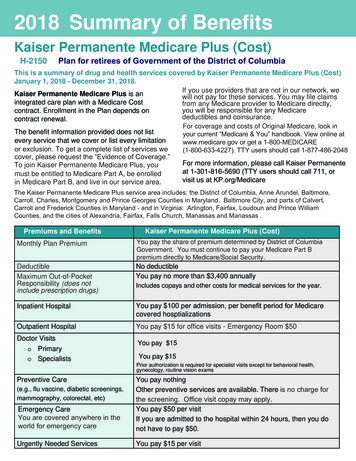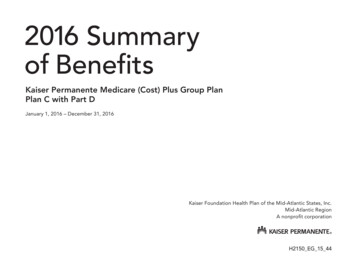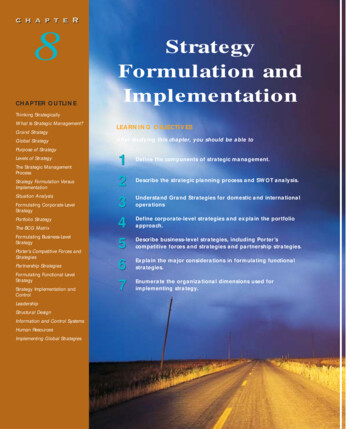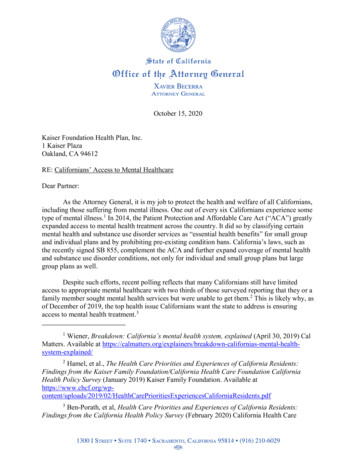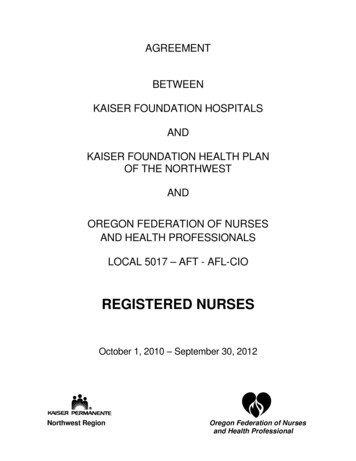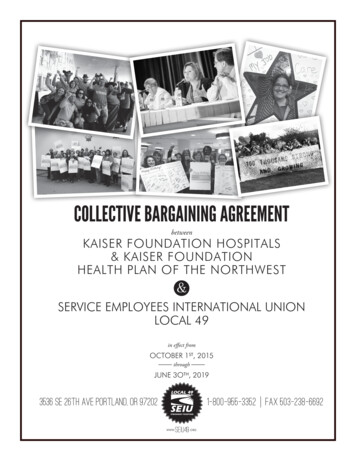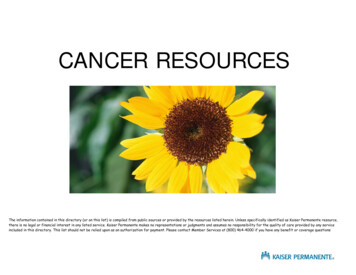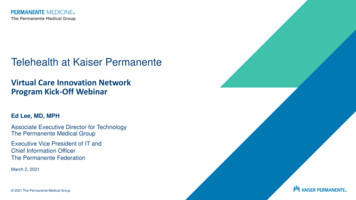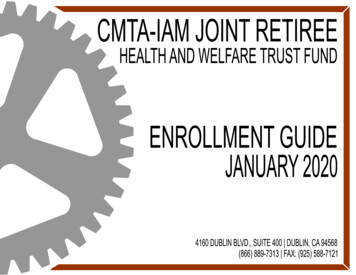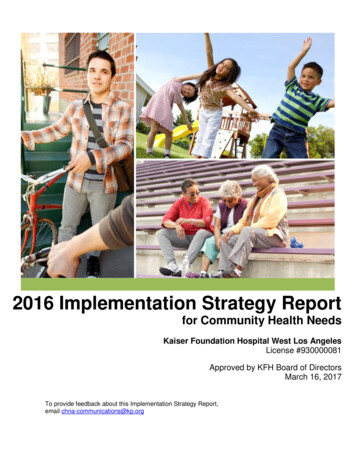
Transcription
2016 Implementation Strategy Reportfor Community Health NeedsKaiser Foundation Hospital West Los AngelesLicense #930000081Approved by KFH Board of DirectorsMarch 16, 2017To provide feedback about this Implementation Strategy Report,email chna-communications@kp.org
Kaiser Foundation HospitalsCommunity Health Needs Assessment (CHNA)Implementation Strategy Report2016Kaiser Foundation Hospitals – West Los AngelesLicense # 9300000816041 Cadillac AvenueLos Angeles, CA 90034I.General InformationContact Person:Date of Written Plan:Date Written Plan Was Adopted byAuthorized Governing Body:Date Written Plan Was Required to BeAdopted:Yesenia Monsour, Director, Public Affairs and BrandCommunicationsDecember 13, 2016March 16, 2017May 15, 2017Authorized Governing Body thatAdopted the Written Plan:Kaiser Foundation Hospital/Health Plan Boards of DirectorsWas the Written Plan Adopted byAuthorized Governing Body On orBefore the 15th Day of the Fifth MonthAfter the End of the Taxable Year theCHNA was Completed?Yes Date Facility's Prior Written Plan WasAdopted by Organization's GoverningBody:December 4, 2013Name and EIN of Hospital OrganizationOperating Hospital Facility:Kaiser Foundation Hospitals, 94-1105628Address of Hospital Organization:One Kaiser Plaza, Oakland, CA 94612No Updated 12/9/20161
II.About Kaiser PermanenteKaiser Permanente is a not for profit, integrated health care delivery system comprised of KaiserFoundation Hospitals, Kaiser Foundation Health Plan, and The Permanente Medical Groups. For more than65 years, Kaiser Permanente has been dedicated to providing high-quality, affordable health care servicesand to improving the health of our members and the communities we serve. Today we serve more than10.2 million members in eight states and the District of Columbia. Since our beginnings, we have beencommitted to helping shape the future of health care. Kaiser Permanente is dedicated to care innovations,clinical research, health education and the support of community health.III. About Kaiser Permanente Community BenefitWe believe good health is a basic aspiration shared by all, and we recognize that promoting good healthextends beyond the doctor’s office and the hospital. Like our approach to medicine, our work in thecommunity takes a prevention-focused, evidence-based approach. We go beyond traditional corporatephilanthropy or grant-making to leverage financial resources with medical research, physician expertise,and clinical practices. Historically, we have focused our investments in three areas—Health Access, HealthyCommunities, and Health Knowledge—to address critical health issues in our communities.For many years, we have worked collaboratively with other organizations to address serious public healthissues such as obesity, access to care, and violence. We have conducted Community Health NeedsAssessments (CHNA) to better understand each community’s unique needs and resources. The CHNAprocess informs our community investments and helps us develop strategies aimed at making long-term,sustainable change—and it allows us to deepen the strong relationships we have with other organizationsthat are working to improve community health.In addition, Kaiser Permanente seeks to promote community health upstream by leveraging its assets topositively influence social determinants of health – social, economic, environmental – in the communitieswe serve.Updated 12/9/20162
IV. Kaiser Foundation Hospitals – West Los Angeles Service AreaKFH-WEST LOS ANGELES SERVICE AREA MAPThe KFH-West Los Angeles service area covers 7 cities and some unincorporated areas. The KFH-West LosAngeles service area includes the cities of Beverly Hills, Culver City, El Segundo, Inglewood, Santa Monica,West Hollywood, and Los Angeles. The city of Los Angeles includes the communities of Baldwin Hills,Cheviot Hills, Crenshaw, Hyde Park, Jefferson Park, La Tijera, Leimert Park, Mar Vista, Mid City, MiracleMile, Ocean Park, Pacific Palisades, Palms, Playa Del Rey, Rancho Park, Rimpau, Venice, Vermont Knolls,West Adams, Westchester, Westwood, and Wilshire among others. Unincorporated areas include LaderaHeights, Lennox, Marina del Rey, View Park, Westmont, Windsor Hills and others.City/CommunityZIP CodeArlington Heights, RimpauBaldwin Hills, Crenshaw, Leimert ParkBel Air Estates, Beverly Glen, BrentwoodBeverly HillsCentury CityCheviot Hills, Rancho ParkCulver CityEl SegundoFairfax/Farmers Market, Miracle Mile, Melrose,Wilshire–La Brea, Park La Brea900199000890049, 9007790210, 90211, 90212900679006490066, 90230, 902329024590036Updated 12/9/20163Service PlanningArea (SPA)4–Metro Los ��South Bay4–Metro Los Angeles
City/CommunityZIP CodeHyde Park, View Park, Windsor HillsInglewood, Westmont, LennoxJefferson Park, Leimert ParkLadera HeightsLos Angeles International Airport, WestchesterMarina Peninsula, Marina del ReyPacific Palisades, Pacific HighlandsPalmsPlaya Del ReyPlaya VistaSanta MonicaSanta Monica—DowntownSanta Monica—Ocean ParkSawtelle, West Los AngelesSouth Los Angeles, Broadway Manchester,Vermont KnollsVeniceWest AdamsWest FairfaxWest Hollywood, West BeverlyWestwoodKHF-West Los Angeles Demographic DataTotal ve American/ Alaskan1%NativePacific Islander/ Native 1%HawaiianSome Other Race17%Multiple Races4%EthnicityHispanic or Latino35%Non-Hispanic65%9004390301, 90302, 90303, 90304,90305, , 90403, 9040490401904059002590037, 90044, 90047, 90062,9000390291900169003590069, 9004890024Service PlanningArea (SPA)6–South8–South 6–South, 8–South Bay5–West6–South5–West4–Metro Los Angeles5–WestKFH-West Los Angeles Socio-economic DataLiving in Poverty ( 200% FPL)41%Children in Poverty29%Unemployed9%Uninsured19%No High School Diploma18%Note: *Percentages were pulled from the CHNA Data Platform inMay ity-health-needs-assessment-chna/)V.Purpose of Implementation StrategyThis Implementation Strategy has been prepared in order to comply with federal tax law requirements setforth in Internal Revenue Code section 501(r) requiring hospital facilities owned and operated by anorganization described in Code section 501(c)(3) to conduct a community health needs assessment at leastUpdated 12/9/20164
once every three years and adopt an implementation strategy to meet the community health needsidentified through the community health needs assessment.This Implementation Strategy is intended to satisfy each of the applicable requirements set forth in finalregulations released in December 2014. This implementation strategy describes KFH-West Los Angeles’splanned response to the needs identified through the 2016 Community Health Needs Assessment (CHNA)process. For information about KFH-West Los Angeles’s 2016 CHNA process and for a copy of the reportplease visit www.kp.org/chna.VI. List of Community Health Needs Identified in 2016 CHNA ReportThe list below illustrates the health needs identified for KFH-West Los Angeles’ service area in order ofpriority as assigned through the 2016 Community Health Needs Assessment (CHNA) process. Drawing fromthe County Health Rankings Model framework1 developed by the University of Wisconsin-MadisonPopulation Health Institute, health issues were identified as either health drivers (social determinants ofhealth) or health outcomes (indicators of morbidity and mortality). Together, health drivers and healthoutcomes are referred to as health needs in the CHNA and below. Health needs and health drivers weregiven equal consideration in the Implementation Strategy development process outlined in the 42526Health NeedsMental HealthDiabetesObesity/OverweightAccess to CareHomelessness and HousingPreventative Health CareEconomic SecurityViolence and Injury PreventionCardiovascular Disease/Heart DiseaseAccess to Healthy FoodsHealthy BehaviorsAlcohol Abuse, Substance Abuse and Tobacco UseHypertensionOral HealthLegal StatusPhysical EnvironmentCancer (includes breast, colorectal, lung, and prostate)Cultural and Linguistic BarriersAsthmaCholesterolTransportationSexually Transmitted DiseaseDental Care AccessDisease ManagementRespiratory Disease (includes COPD)Maternal and Infant iverDriverOutcomeOutcomeCounty Health Rankings Model developed by the University of Wisconsin-Madison Population HealthInstitute: Updated 12/9/20165
272829Health NeedsHIV/AIDSAlzheimer's DiseaseCommunicable Diseases (including Hepatitis A and B)OutcomeOutcomeOutcomeVII. Who was Involved in the Implementation Strategy DevelopmentThe implementation strategy was developed through a process that involved the KFH-West Los Angeleshospital operational leadership and community partners. The core planning team consisted of theKHF-West Los Angeles service area’s Operations Leadership Team (OLT), comprised of stakeholdersrepresenting both Kaiser Foundation Hospital/Health Plan and the Southern California PermanenteMedical Group (SCPMG) and included: Jason Alcantara, Consultant, Strategy, Decision Support & TransformationRaye M. Burkhardt, RN, MSN, Chief Nurse ExecutiveCelia Brugman, Community Benefit ManagerJohn E. Chew, MPH, Assistant Medical Group Administrator, Surgical Services and Women &Children Service LinesEugene Cho, Chief Operating OfficerJoan Crawford, RN, BSN, MBA, Assistant Medical Center AdministratorJulia Garcia-Ricketts, Area Recruitment ManagerBrooke Greenlee, Health Education DirectorLaTonya Hines, MD, OBG/YNSunny H Lee, Pharm.D, Area Pharmacy & Residency Director PGY1Yesenia Monsour, Public Affairs and Brand Communications Director, Cultivate ChairKatherine Pantele, Member Services DirectorLisa Saldana, Consulting and Performance Improvement Director, Cultivate ChairStephen Tarzynski, MD, PediatricsRhonda Tribble, Human Resources DirectorManuel Villagomez, Finance and Revenue Cycle Directora. Partner OrganizationsThe following partner organizations provided their input on and insights into the implementation strategiesoutlined in this report. These partner organizations were invited among others because of their deepknowledge of the culturally and linguistically diverse resident population of the KFH-West Los Angelesservice area and their experience working to address issues pertaining to the selected health needsincluding: access to care; the broader economic security of service area communities; public healthpartnerships; and, mental and behavioral health. These partner organizations were able to providemultiple perspectives on strategic partnerships and effective programs that currently address the healthneeds selected by KFH-West Los Angeles. California Community FoundationCedars-Sinai Medical Center, Community Benefit Systems and PlanningLos Angeles Department of Public HealthLos Angeles Trade Technical CollegeProvidence St. John’s Health CenterSkid Row Housing TrustUCLA HealthWest Angeles Community Development CorporationUpdated 12/9/20166
Worker Education and Resource Center, Inc.b. Community Engagement StrategyWhile not required by Federal CHNA regulations, Kaiser Permanente encourages all KFH facilitiesdeveloping Implementation Strategy plans to elicit community input throughout the plan developmentprocess. Voluntary community member and stakeholder engagement in the implementation strategydevelopment process is intended to enable: KFH facilities to develop a deeper understanding of community perspective in developingImplementation Strategies, allowing opportunities for increased collaboration, potential impact,and sustainabilityOpportunities to engage community members beyond organizations and leaders with whomfacilities may typically collaborateTransparency throughout the implementation strategy development processOpportunities to inform community leaders about Kaiser Permanente’s unique structure andresources to effectively foster meaningful partnerships.In September 2016, KFH-West Los Angeles invited community partners and stakeholders to attend abreakfast and strategic discussion addressing selected priority health needs and implementation strategyoptions (see table below for participant organizations). Eleven community stakeholders attended andreviewed the KFH-West Los Angeles CHNA and Implementation Strategy process and four primary healthneeds were brought to the forefront of the discussion: access to care, economic security, mental andbehavioral health, and obesity/overweight/diabetes. Stakeholders were asked to provide their feedbackand recommendations with respect to existing programs, partnerships and collaborations that could beleveraged to address the implementation strategies ng, focusNumber Number of Numbergroup, interview, Respondent’s title/role andTotaloforganizational ofrepssurvey, written organization or focus group number of etc.Updated 12/9/20167
Area Health Officer, Los AngelesDepartment of Public Health;110101Associate Director CommunityBenefit Systems and Planning,Cedars-Sinai Medical CenterDean, Los Angeles Trade TechnicalCollege;StakeholdersBreakfastStrategy DiscussionDirector of Community HealthPartnerships, Providence St. John’sHealth CenterDirector, Worker Education andResource Center, Inc.Executive Director, West AngelesCommunity DevelopmentCorporationGrants Coordinator, Skid RowHousing TrustSenior Program Officer, CaliforniaCommunity FoundationStrategic Development Manager,UCLA HealthCommunity stakeholders shared that gaps in access to care in the service area are in part related to thelack of a culturally aligned healthcare workforce: the entire group strongly advocated for efforts that wouldsupport the cultivation of health care leaders and providers from within the communities that are currentlyunderserved and/or accessing preventive and specialty care at low rates. Efforts to develop a moreculturally aligned workforce will facilitate the building of trust and long-lasting relationships betweenhealth care providers and patients. These efforts may also contribute to economic development throughnew education and certification programs of the healthcare workforce. A recent initiative of the CaliforniaCommunity Foundation is an example: the foundation partnered with an Immigrants’ Rights organizationsthat trained community members as “navigators” who provided culturally aligned healthcare accesssupport to residents, increasing insurance enrollments and helping families connect with and visithealthcare providers.In sharing about existing successful public health programs, community partners highlighted theimportance of trauma-informed care and trauma-informed health education, particularly in the areas ofthe KFH-West Los Angeles service area with highly vulnerable populations. Community partners explainedthat trauma-informed approaches support mental and behavioral health efforts as well as diseaseprevention and treatment—an important point to consider in communities with very high need for mentalhealth services.As a result of the strategic conversation outlined above, KFH-West Los Angeles was able to identifypotential partner organizations and initiatives that are aligned with the implementation strategies outlinedin this report.In addition, KFH-West Los Angeles maintains conversations with community organizations to clarifyopportunities to partner and to align strategies to address community health needs. KFH-West Los Angelesdrew from others’ expertise to learn about existing programs and initiatives and identify future areas ofcollaboration with funders and other key stakeholders, including the California Community Foundation,Cedars Sinai, Community Coalition, Community Health Councils, LA Care, the Los Angeles CountyUpdated 12/9/20168
Department of Public Health, Mid Town Homeless Coalition, Partners in Care, UCLA, Venice Family Clinic,Westside Coalition, Wise and Healthy Aging among others.c. Consultant UsedThe Center for Nonprofit Management (CNM), established in 1979, is the Southern California source formanagement education, training, and consulting within the nonprofit community. From core managementfundamentals to in-depth consulting in planning, organizational effectiveness and evaluation, executivecoaching and other services, CNM enables individuals to become better leaders of more effective organizations. The CNM team has been involved with CHNAs for hospitals throughout Los Angeles County andSouthern California for over 12 years. The CNM team conducted the 2004, 2007, and 2010 assessments forthe Metro Hospital Collaborative (California Hospital Medical Center, Children’s Hospital Los Angeles, GoodSamaritan Hospital, Kaiser Foundation Hospital Los Angeles, Queens Care, and St. Vincent Medical Center).CNM conducted the 2013 CHNAs for three Kaiser Foundation hospitals and one non-Kaiser Foundationhospital in the greater Los Angeles area, three Glendale hospitals, and the 2013 Metro HospitalCollaborative (California Hospital Medical Center, Good Samaritan Hospital and St. Vincent MedicalCenter), and assisted an additional two Kaiser Foundation Hospitals (Panorama City and San Diego) inCommunity Benefit Implementation Strategy planning based on the needs assessments. In 2016, CNMproduced CHNAs for two Kaiser Foundation Hospitals (Baldwin Park and West LA) and is working on theImplementation Strategy for both medical centers; CNM also accomplished CHNAs for Citrus Valley HealthPartners, the Glendale and Metro Hospital collaboratives.VIII. Health Needs that KFH-West Los Angeles Plans to Addressa. Process and Criteria Used to Select Health NeedsA series of meetings took place with the core planning team to examine and identify the health needs KFHWest Los Angeles will select for its 2017-2019 implementation strategy period. Early in the process, theplanning team voted to focus the planning conversation on the top 12 needs as prioritized by thecommunity. Individual health need data and background packets were prepared for review and discussionto further the collective understanding of the top health needs. The top 12 health needs were collapsedinto eight health needs to align with other Southern California KFH hospitals and support a more effectiveanalysis and comparison among needs. For instance, the health needs originally identified through thecommunity health needs assessment process included Obesity/Overweight, Diabetes, Healthy Behaviors,and Access to Healthy Foods; these were merged into the overall category of Obesity/HEAL/Diabetes.In addition, the planning team reviewed a set of additional data available through community data portalsas well as KP membership, such as population vulnerability index, emergency department utilization, risk offuture illness and the overlay of data and geographies for the KFH- West Long Angeles Service Area and theLA County Service Planning Areas (SPAs).To facilitate a decision-making process on the health needs KFH-West Los Angeles will focus on, the Centerfor Nonprofit Management worked closely with the Community Benefit Manager to apply a set of criteria(magnitude, severity, disparities, KP assets and ability to leverage; see table below) to each health needand to prepare preliminary scores for each health need based on these criteria. As needed, prior to theworking session additional data were collected to support evaluation of each health need according tomagnitude, severity, disparities, KP assets and ability to leverage.Updated 12/9/20169
CriteriaDefinitionMagnitude/scale of theproblemThe health need affects a large number of people within the community.Severity of the problemThe health need has serious consequences (morbidity, mortality, and/oreconomic burden) for those affected.Health disparitiesThe health need disproportionately impacts the health status of one or morevulnerable population groups.KP assetsKP can make a meaningful contribution to addressing the health need becauseof its relevant expertise and/or unique assets as an integrated health systemand because of an organizational commitment to addressing the health need.Ability to leverageOpportunity to collaborate with existing community partnerships working toaddress the health need, or to build on current programs, emergingopportunities, or other community assets.The criteria were divided into two categories: ‘need’ and ‘feasibility’ (see table below). All 10 health needswere rated on a scale of 1-5 for each criterion; therefore, a total ‘need’ score of 15 and a total ‘feasibility’score of 10 was possible.Need Criteria1. Magnitude2. Severity3. DisparitiesFeasibility Criteria4. KP Assets5. Ability to LeverageOnce each health need was rated, the health needs were charted on a grid illustrating the communityranking, need score and feasibility score of each (see below). ‘High need’ was defined as a need score of10-15; ‘medium need’ was defined as a need score of 5-10; ‘high feasibility’ was defined as a feasibilityscore of 8-10, and ‘medium feasibility’ was defined as a feasibility score of 3-7.Updated 12/9/201610
Through consideration of need and feasibility combined with community ranking and desire to leverageexisting KFH-West Los Angeles assets and community programs, the KFH-West Los Angeles core planningteam narrowed down the original list of eight health needs to four. Through discussion it became apparentthat it was possible to account for some health needs by incorporating elements of them into broaderhealth needs (e.g. Cardiovascular Disease/Heart Disease is addressed through Obesity/HEAL/Diabetesstrategies; Substance Abuse is addressed by a Mental and Behavioral Health strategy). In addition, becauseof the size of the KFH-West Los Angeles service area, the ISET team chose to focus on health needs thatwere most severe in areas of the service area with the most vulnerable populations. This process resultedin the selection of four health needs (listed in alphabetical order):1.2.3.4.Access to CareEconomic SecurityMental and Behavioral HealthObesity/HEAL/Diabetesb. Health Needs that KFH-West Los Angeles Plans to AddressAccess to CareAccess to care is defined as access to high quality, affordable, holistic and culturally responsive care. In theKFH-West Los Angeles service area, barriers to access to care include not only high rates of uninsurance,but also a service provider shortage in some communities, a lack of a culturally responsive healthcareworkforce and an overdependence among younger residents on emergency care (instead of preventivecare). More specifically, more than one in four (25.7%) residents between the ages of 18 and 64 areuninsured. Additionally, nearly one in twenty people (4.11%) in the KFH-West Los Angeles service area livein a Health Professional Shortage Area (HPSA). Approximately one in six residents in the KFH-West LosAngeles service area (16.7%) experience a lack of usual source of primary care. However, South Los Angelescommunities have a very high penetration of community clinics into the total population. Between 22.5%and 28.4% of the populations in ZIP codes 90037, 90003, 90062 and 90044 receive care at communityUpdated 12/9/201611
clinics2. This indicates a great potential for KFH-West Los Angeles to coordinate with existing assets toexpand community-based preventive services and build trust and strong relationships with healthcareproviders. Access to care was selected as a health need because of the high community rating, the severityof the issue in the service area, and the great interest and potential to make an impact through strategicpartnerships and investment.Economic SecurityEconomic security is defined as having stable access to employment, educational and housingopportunities and other factors that influence health including access to affordable fresh food. Economicsecurity was chosen by the ISET team as a health need because of the high community rating, the severityof the issue in the service area, and the depth and breadth of partner organizations working in this issuearea.In the KFH-West Los Angeles service area, one in five (20.3%) residents live on an income below 100% ofthe federal poverty level. Nearly one third of the children (31.5%) in the service area are living below thefederal poverty level. About one sixth (14.6%) of the service area population experiences food insecurity. Inaddition, the unemployment rate in the KFH-West Los Angeles service area (8.9) is higher than Los AngelesCounty (5.5). For these reasons, economic security issues of focus in the KFH-West Los Angeles service areainclude affordable housing, employment opportunities in communities with high concentrations ofresidents with low education levels, and utilization of affordable food programs. Stakeholders emphasizedthat economic security initiatives should leverage opportunities to collaborate with KFH-West Los Angelespartner organizations that serve youth: several new and upcoming community initiatives create pipelinesto jobs for young people—particularly those interested in healthcare careers.Mental and Behavioral Health (Including Substance Abuse)Mental and Behavioral Health is a combination of Mental Health and Alcohol Abuse, Substance Abuse andTobacco Use. Mental health refers not only to the absence of negative mental health states (anxiety,depression, mental illness) but also the presence of positive mental health states (self-worth, satisfaction,effective emotional regulation, etc.). Mental and Behavioral health was chosen as a health need because ofthe high community rating and also because of the severity of the issue in the service area. Nearly one infive (18%) adults in the KFH-West Los Angeles service area self-reported that there was a time during thepast 12 months when they felt they might need to see a professional because of problems with theirmental health, emotion, nerves or use of alcohol or drugs. KFH-West Los Angeles (168.6) also exceeded LACounty (125.8) and the state (102.5) in the rate of alcohol and drug induced mental health disease per100,000. In the KFH-West Los Angeles service area, women are more impacted by depression than men.Nearly one in ten (10.1%) women in the service area suffer from depression.Mental and behavioral health issues of focus for the KFH-West Los Angeles service area include theprovision of high quality mental health care services to the service area, and increasing knowledge andcapacity to increase the provision of trauma-informed services to youth, and educate the public around therisks of prescription drug abuse. Stakeholders highlighted the fact that at present, physicians shoulder theburden of the high need for mental health and substance abuse services in the service area, and it hasbeen a challenge to scale up mental health/substance abuse prevention efforts. Stakeholders alsohighlighted the fact that mental and behavioral health go hand in hand with economic security andhomelessness—two issue areas that may be impacted through strategy investment in mental health care.2http://www.udsmapper.org/index.cfmUpdated 12/9/201612
Obesity/Healthy Eating Active Living (HEAL)/DiabetesObesity/HEAL/Diabetes is a combination of Diabetes, Obesity/Overweight, and Healthy Behaviors or HEAL(healthy eating, active living). Obesity/HEAL/Diabetes was chosen as a health need through the ISETprocess because of the magnitude and severity of diabetes and obesity in the service area. Nearly one third(30.7%) of the population of the KFH-West Los Angeles service area 12 years of age and older areoverweight, and nearly one-fifth (19.6%) are obese. Over two-fifths (43.12%) of the children in grades 5, 7and 9 in the KFH-West Los Angeles service area were in the “High Risk” zone for body compositionaccording to the Fitnessgram physical fitness test.3 Additionally, nearly three times as many adults in theKFH-West Los Angeles service area (8.2 per 10,000) were hospitalized for uncontrolled diabetes as inCalifornia (2.8 per 10,000). Given the high rates of diabetes and obesity in the service area, access tohealthy food, opportunities for leisure and physical activity, and greater support for communities adoptinghealthy behaviors and improving access to chronic disease management are areas of focus for KFH-WestLos Angeles investments in Obesity/HEAL/Diabetes.IX. KFH-West Los Angeles’s Implementation StrategiesAs part of the Kaiser Permanente integrated health system, KFH-West Los Angeles has a long history ofworking internally with Kaiser Foundation Health Plan, The Permanente Medical Group, and other KaiserFoundation Hospitals, as well as externally with multiple stakeholders, to identify, develop and implementstrategies to address the health needs in the community. These strategies are developed so that they: Are available broadly to the public and serve low-income individuals. Reduce geographic, financial, or cultural barriers to accessing health services, and if they ceased wouldresult in access problems. Address federal, state, or local public health priorities. Leverage or enhance public health department activities. Advance increased general knowledge through education or research that benefits the public. Otherwise would not become the responsibility of government or another tax-exempt organization.The following represents the goals, strategies and expected outcomes for each of the health needs KFHWest Los Angeles plans to address for the 2017-2019 Implementation Strategy (IS) timeline. KFH-West LosAngeles will draw on a broad array of organizational resources to implement these strategies, such
South Los Angeles, Broadway Manchester, Vermont Knolls 90037, 90044, 90047, 90062, 90003 6-South, 8-South Bay Venice 90291 5-West West Adams 90016 6-South West Fairfax 90035 5-West West Hollywood, West Beverly 90069, 90048 4-Metro Los Angeles Westwood 90024 5-West Multiple Races


